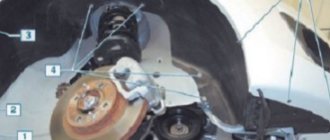In today's test we will talk about the most important drive in a car - the gas distribution mechanism drive, or timing. We will test timing belts for the most popular car on the Russian market - Lada Granta with an 8-valve engine 21116 and its modifications (a belt with a rounded tooth, having 113 teeth and a width of 17 mm).
The tests will take place in two stages: bench and resource.
Components / Articles
All about belt drive systems
The first is divided into several tests, but the results of the resource test will be known only by the end of summer. So, let's see.
During a search in stores, it turned out that in our region you can buy this belt from only three manufacturers: ContiTech, Gates and Trialli .
The first two belts can be purchased separately, only Trialli is sold as a repair kit with a tension pulley.
Price: 800 rubles
The belt is in branded cardboard packaging, on the box there is a sticker with a QR code. The kit includes a sticker that indicates the date of replacement and mileage, as well as which of the components - roller, belt, pump - were replaced. This is convenient: you won’t have to struggle to remember when the last belt replacement was made and what exactly was replaced. In addition to branded and general designations, the belt is marked with a batch number.
Timing belt replacement interval for Lada Granta
To avoid premature breakage of the timing belt, it should be changed according to the regulations - once every 75 thousand km, however, it is better to visually monitor the condition of the belt drive much more often and at least after a mileage of 15 thousand km, otherwise irreparable things may happen.
As mentioned above, only the 11183-50 engine does not bend the valves; in other cases, it will definitely not be possible to avoid serious damage due to the breakage of a worn or incorrectly installed belt, and subsequent expensive repairs. It is for this reason that many experts recommend changing the timing belt drive much earlier than the deadlines regulated by the manufacturer.
Test method
Strength tests of belts were carried out in the testing laboratory of PJSC NPO on R-10 and MR-05 tensile testing machines.
Frost resistance and life tests were carried out in the testing laboratory of NPO Talis.
The testing of timing belts was carried out according to TU 38.1051912-90 “Toothed belts with a parabolic tooth profile for VAZ car engines.” The factor of the parabolic profile standard for belts with a rounded profile in this case is not significant, since the tested belts are actually intended for the good old “eight” engine, which means that the forces transmitted by the timing belt remained at the same level.
The first test was to check the bending resistance of the belts. This test uses a smooth pulley with a diameter of 50 mm. One belt of each type undergoes an artificial aging procedure, which is carried out as follows: the belt is placed in a heat chamber with a temperature of 120 degrees and maintained for 70 hours. The other belt is frozen along with the pulley at -45 degrees for 24 hours.
Afterwards, the belts are removed and bent over a smooth pulley with the teeth outward by 180 degrees. Tears and cracks are not allowed in the bend zone. The frozen belt bends on a pulley that was previously cooled along with the belt.
All belts passed this test.
At the next stage, we checked the strength qualities of the belts.
First, the belts were tested for breaking force. According to the standard, the minimum tensile strength of a belt should be at least 8 kN/cm for a new belt and 7 kN/cm for a belt that has undergone artificial aging. Thus, with a belt width of 17 mm, the minimum breaking force should be at least 13,600 N, and for artificially aged belts - at least 11,900 N.
This test is carried out as follows: the belts are installed with the teeth outward on smooth cylindrical pulleys and stretched at a speed of 50 ± 15 mm/min until breaking on a R-10 tensile testing machine.
The breaking force test results are shown in Table 1 .
As can be seen from the test results, all belts have a good margin of cord strength (from 1.43 to 1.8 before aging and from 1.68 to 2.1 after aging). The strongest cord turned out to be the Continental CT 1164 belts: it can withstand loads of up to 2.5 tons.
But in a belt, the strength of the cord is not the most important indicator. Therefore, as a second strength test, the tooth resistance to tearing off of new and artificially aged belts was checked. This figure must be at least 92 kgf for each centimeter of belt width - both new and old. Knowing that the width of the tested belts is 17 mm, we obtain a force of 156.4 kgf.
This test is carried out using a special device that has a toothed pulley with a tooth profile corresponding to the belt being tested. The device contains a calibration spring, which presses the belt through a metal plate to the toothed pulley with the required force, in our case it is 119 N. The belt is cut, one end is installed in the device so that the fifth tooth from the top of the cut belt falls into the pulley socket. The lower end is fixed in the clamp, and the MP-05 tensile testing machine pulls it down.
The results of this test are shown in Table 2 .
On new belts, the teeth did not cut off: the rubber is still plastic, the tooth simply deforms and jumps. But with aged belts, tooth shearing occurs on their “hardened” teeth - this is what happened with the Continental CT 1164 and Trialli GD 790; Gates 5670XS had a tooth deformation and it jumped. The test results show that all belts have a good shear strength (from 1.95 to 2.43 before aging and from 2.1 to 2.51 after aging). The timing belt from Trialli turned out to be the most resistant to tooth shearing.
Some people may find it strange that strength increases after artificial aging. This is explained by the properties of heat-resistant rubbers that are used to make belts: with prolonged heating, their internal bonds are strengthened.
According to statistics, replacing timing belt tension rollers occurs more often than replacing the belt itself. Therefore, it is worth periodically listening to see if there is noise from the rollers, because a failed roller will ruin the timing belt, no matter how good it is, which can lead to expensive engine repairs.
In what cases does a belt break?
- Exceeding the permissible replacement interval without carrying out intermediate prevention;
- Systematic operation of the power unit under loads for which it is not designed;
- Defects in the manufacture of a part or component;
- Frequent contact with the surface of oil, chemical reagents, compounds that cause a reaction, delamination of rubber;
- Drive tension exceeds the permissible norm;
- Insufficient drive tension;
- Tooth wear, deformation, damage.
The duration of the engine operation after time “H” is also an important factor. The faster the driver turns off the ignition, the less disastrous the consequences and vice versa. Service station mechanics know of cases where the rocker arm and valve bases literally pierced the wall of the cylinder block and came out.
Resource test
To determine the service life of belts, there are special stands, one of which is located in the laboratory of NPO Talis LLC. This stand completely replicates the geometric arrangement of the units (pulleys and belt tension rollers) that come into contact with the drive belt when operating the engine; more precisely, when creating this stand, standard units were used, which are installed on internal combustion engines produced by VAZ. The stand is universal and provides the ability to install belts that are used for both 8-valve and 16-valve engines of front-wheel drive cars produced by AvtoVAZ. Also, by replacing the pulleys, it becomes possible to test belts with both trapezoidal and semicircular tooth shapes.
The belt is driven by a toothed pulley, which rotates a 7.5 kW electric motor - it acts as a crankshaft, causing all drive units to rotate using the timing belt. The belt is tensioned using the standard timing belt tension roller. The role of the camshaft is performed by an electric brake, which, when braking, creates a resistance of 27.5 N/m - this is a five-fold overload of the force that, during normal operation, is transmitted by the timing belt in an 8-valve engine. Thus, we turn every hour of belt running on the stand into five hours of work on the car.
According to the test method TU 38.1051912 “Toothed belts for VAZ engines,” the belt must have run for at least 100 hours, which turns into 500 hours of run time during normal engine operation. To fully simulate operating conditions, the space in which the timing belt operates is covered with a casing with thermal insulation installed in it, and the working area is heated to a temperature of +90 degrees - this requirement is not found in either the specifications or in any of the test methods known to us, but we decided make the job more difficult for the belt. When braking, the electromagnetic brake converts all incoming rotational energy into heat - and requires cooling, so an autonomous pressure cooling system is organized for the electric brake, which takes up no less space than the stand itself.
Test results
None of the timing belts we tested presented any surprises—all of them honestly worked the required 100 hours on the bench. When inspecting each timing belt after testing, no damage was found that could indicate imminent failure of any of the belts.
Replacing the timing belt on 8-valve internal combustion engines Lada Granta
There is nothing complicated in the process of replacing the belt on Grant cars equipped with 8-valve units; you can even do it yourself.
- After removing the terminals from the battery, remove the alternator belt.
- Next, remove the front upper cover of the timing mechanism itself - for subsequent installation of the piston of the first cylinder in the TDC state.
- To replace a worn belt, you need to loosen the tension roller nut.
- Next, you need to unscrew the main bolt at the generator drive pulley and remove it. This can be done with a regular key.
- Afterwards, by removing the three mounting bolts, you need to dismantle the lower timing cover.
- The belt itself is removed together with the tension roller. You should start removing the belt drive from the camshaft pulley.
- At the time of installation, carried out in reverse order, it is necessary to ensure the correct belt tension.
Malfunctions: causes, elimination
Like all internal combustion engines with mechanical adjustment of valve clearances, the 11186 engine requires periodic adjustment of this characteristic. In addition, during operation, characteristic “diseases” of this particular version of the power drive were identified:
| Timing belt | 3/50 |
| battery | 1/20 |
| Valve clearances | 2/20 |
| Crankcase ventilation | 2/20 |
| Belts that drive attachments | 2/20 |
| Fuel line and tank cap | 2/40 |
| Motor oil | 1/10 |
| Oil filter) | 1/10 |
| Air filter) | 1 – 2/40 |
| Fuel filter) | 4/40 |
| Heating/Cooling Fittings and Hoses | 2/40 |
| coolant | 2/40 |
| Oxygen sensor | 100 |
| Spark plug | 1 – 2/20 |
| Exhaust manifold | 1 |
| Bend valves | broken timing belt | periodic wear monitoring |
| Ignition system interruptions | failure of the corresponding block | replacing the ignition module |
| Increased oil consumption | development of main liners |
stuck piston rings
When repairing piston and crankshaft engines, it is recommended to use original components from the AvtoVAZ manufacturer. Because only he uses special technologies for strengthening structural materials. From third-party companies, the metal may be “raw”; the resource of such consumables cannot be analyzed.
Delivery by Russian Post (cash on delivery, no prepayment)
Advantages: the most widespread network in Russia, delivers to any corner of the country, including remote ones. Flaws:
- high cost of delivery of heavy or large parcels, as well as the weight of one parcel should not exceed 20 kg;
- long delivery times and queues in large cities for receipt.
To send your order by Russian Post:
- Place an order in our online store by phone or on the website (registration is not necessary);
- After we receive it, our manager will contact you by phone to clarify the cost, delivery time and your wishes. Next, we will pack your order carefully and then send it to you;
- You will receive the tracking number of the shipment via SMS from us and from the Russian Post; the message will indicate the full cost of the purchase, including delivery to your locality (that is, the cost of your order plus the cost of delivery by cash on delivery). You can control the status of the order coming to you using our tracking service, as well as independently, on the Russian Post website using the track number;
- To the Post Office, you will only have to pay the cost, including delivery.
Delivery time may vary depending on how far your locality is from Togliatti and usually ranges from 5 to 14 days.
The cost of delivery is calculated based on the volume, weight of the selected product and the distance to the recipient's settlement.
Required for sending:
- indicate full name recipient;
- Your mailing address;
- Your phone number (contact);
- Post office code.
Russian Post commission for cash on delivery service:
- purchase price up to 1,000 rubles. – 70 rubles + 5% of the amount;
- purchase price from 1,000 to 5,000 rubles. – 80 rubles + 4% of the amount;
- purchase price from 5,000 to 20,000 rubles. – 180 rubles + 2% of the amount;
- purchase price from 20,000 to 500,000 rubles. – 280 rubles + 1.5% of the amount.
Russian Post - Delivery of goods up to 20 kg throughout Russia. https://www.pochta.ru
Technical characteristics of the VAZ 11186 1.6 8kl engine
| Type | in-line |
| Number of cylinders | 4 |
| Number of valves | 8 |
| Exact volume | 1596 cm³ |
| Cylinder diameter | 82 mm |
| Piston stroke | 75.6 mm |
| Supply system | injector |
| Power | 87 hp |
| Torque | 140 Nm |
| Compression ratio | 10.3 — 10.5 |
| Fuel type | AI-92 |
| Environmental standards | EURO 4 |
conclusions
Of course, a broken timing belt on a Lada Granta can cause a lot of problems. But this does not mean at all that we cannot do anything. There are some recommendations that will help you reduce the risk of such a breakdown to a minimum. The first step is to carefully check the condition of the belt. Some recommend checking the condition after 10 or 20 thousand kilometers. Also try to monitor the condition of the seals. It is not necessary to even look under the hood, since when they wear out, characteristic stains will appear on the asphalt. The flashing of the emergency lamp, which indicates problems with pressure and oil level, will also indicate problems. If this happens, then the engine must be turned off immediately and the reason for this “behavior” of the car must be found. When replacing the timing belt, only original spare parts should be used. But even branded parts will need to be constantly monitored.
Some tips on the replacement procedure
If you set out to replace the component yourself, then you should not neglect some of the recommendations below. In particular, do not forget to observe the interval at which you change the timing belt.
After hanging the belt, its correct tension is required. This is done through the use of a specialized key. Some “figures” will object, they say, we can do without it. However, here it is very problematic to dare to guarantee a high-quality result. The force applied to the belt branch (when rotated at a 90-degree angle), located between two shafts (well-known: camshaft and crankshaft), should not exceed 20 Nm, but it should not be less than 15 Nm. If there is no “fall” within the designated parameter range, this indicates incorrect belt tension. There is only one consequence - a new regulation!
Preparatory operations
First, disconnect the negative battery terminal, remove the engine protection and drain the antifreeze.
Engine 16 valves Priora.
Remove the protective cover, not forgetting to disconnect the absorber purge valve.
What cars are equipped with the VAZ 11186 engine?
This power unit was intended for Kalina and Granta; 21116 was installed on Priora:
Lada
| Granta sedan 2190 | 2011 - present |
| Granta liftback 2191 | 2014 - present |
| Granta hatchback 2192 | 2018 - present |
| Granta hatchback 2192 | 2018 - present |
| Grant station wagon 2194 | 2018 - present |
| Kalina 2 hatchback 2192 | 2013 — 2018 |
| Kalina 2 station wagon 2194 | 2013 — 2018 |
| Kalina 2 Cross 2194 | 2014 — 2018 |
Datsun
| On-Do 1 | 2014 - present |
| Mi-Do 1 | 2015 - present |
Similar engines from other manufacturers:
Alternative manufacturers
Not all vehicle owners can choose the right spare part for their car. This is due to the wide variety of products, including timing belts. The main supplier of rubber products for VAZ cars is the RTI plant in Balakovo. In addition to this, sellers can offer buyers Bosch products, which have high quality workmanship and reliability. Also on display you can see products from] Daiko[/anchor], Kontitek, Lynx. Their cost ranges from 700 to 1500 rubles.
Reviews
Sergey. Moscow city. I decided to tidy up the timing drive mechanism on my Priora. Experts suggested trying a product from Contitech. I don’t know why they chose this belt, but it has been working for more than 30 thousand km without any complaints.
Nikolai. Tambov. On the engine of my car, the timing belt broke and two valves were bent. The engine was repaired by specialists who chose a belt from Bosch. After a run of 10 thousand km, we checked the condition and tension in the timing drive, there were no comments.










